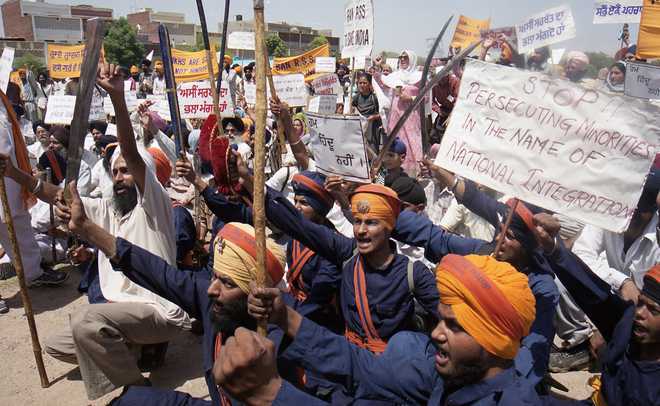
On the back foot: In case of Sikhs, the RSS replaces confrontation with persuasion and even hasty backtracking in Punjab tribune photo: Manoj Mahajan
Sandeep Dikshit
How does a politically not-so-inclined person decipher the alphabet soup of organisations enjoying unprecedented ascendency under the BJP government at the Centre? Journalist Dhirendra Jha seems to be the first off the block with his dissection of eight of the three dozen Sangh Parivar affiliates running 1.5 lakh projects, all committed to making secular India into a Hindu Rashtra.
Though they publicly eschew politics, like their mother organisation, the Rashtriya Swyamsevak Sangh (RSS), they are all political instruments to turn India into a Hindu Rashtra. Some like the benign Bhartiya Mazdoor Sangh are owned up by the RSS. But there are many who operate in the realm of deniability. Whenever their utterances or violent actions cause widespread distaste, the RSS quickly labels them as fringe organisations. But they are all united in their aim to force down the throat a one-size-fits-all definition of national identity.
For better comprehension, Dhirendra Jha divides the eight outfits into two categories. Four formally belonging to the Sangh Parivar: the Bajrang Dal, the Rashtriya Sikh Sangat, the Bhonsala Military School and the Hindu Aikya Vedi. The other four — Sanatan Sanstha, the Hindu Yuva Vahini (the pretence is now over and its chief Yogi Adityanath is now the UP Chief Minister), the Sri Ram Sene and Abhinav Bharat — are technically, unaffiliated, with the Sangh Parivar.
All of them subscribe to Savarkar’s definition of a Hindu (before DNA testing came into vogue) — someone who carries the blood of the great race of the Vedic people.
Being a journalist, Dhirendra Jha presents a racy read on the lines of Pralay Kanungo’s RSS’s Tryst with Politics, Neeladri Bhattacharya’s Khaki Shorts and Saffron Flags and Paul Brass’ Theft of an Idol. Based on extensive field work like his first tome, A Dark Night in Ayodhya, that gave a vivid account of how the then Mahant of Gorakhpeeth, aware of the disruptive potential of a Ram Mandir, conspired to surreptitiously place idols in Babri Masjid. It similarly avoids the didactic tone of armchair academics that fail to bring the flavour of the communal fire smouldering in the fields and bylanes of India. The field work enables greater insight into the actual mechanisms that underlie the evolution of these fringe outfits.
Most instructive is their birth — almost all took shape when (i) the Babri Masjid demolition movement was at its peak; (ii) when the NDA-I of Atal Behari Vajpayee, said to be a benign version of the current dispensation at the Centre, was in power, and (iii) in the wake of the Gujarat riots.
And almost all of them have their hands dipped in blood — either their own (inadvertently) as in the case of the Sanathan Sanstha whose two members were blown up by a bomb they were carrying or of septuagenarians (Narendra Dabholkar, Govind Pansare and M M Kalburgi) because their erudition and wisdom punched gaping holes in their half-baked ideologies.
In some cases, such as the current UP Chief Minister-led Hindu Yuva Vahini, was guided by cold electoral calculations. After his victory margin of 20,000 was pared to just 7,000 votes in the 1999 Lok Sabha elections, Yogi embarked on a grave-digging spree (now we know where Narendra Modi’s kabristan jumla originated from) and despite his recently-displayed love for men in uniform, he was present when a Head Constable of the UP Police was shot dead for trying to foil their attempts. The result: Yogi’s victory margin was three lakh votes in 2009 despite the Congress enjoying a rare upsurge in UP with 20 Lok Sabha seats. The Bajrang Dal cut its teeth by allegedly burning alive a sleeping Christian missionary Graham Staines with his two minor sons in 1999.
Dhirendra Jha also brings to light the wishy-washy approach of the Congress. Sanatan Sanstha, whose men were charged for murder of the three rationalists, wasn’t banned despite a 1,000 page police dossier. Later, the then Union Home Minister Sushil Kumar Shinde and Maharashtra CM Prithviraj Chavan blamed each other.
There is also money to be earned much like the gau rakhsaks of today — the same Bajrang Dal goons who target Muslim business establishments — then step in to provide security services! The most hilarious part is reserved for the last — how the garv-se-kaho brigade of alpha males invariably backtracks when it comes up against the Akal Takht or the Sikh hardliners. That is when they quickly jettison their calling cards of hate speech, violence and even terror. In the end they remain pathetic but dangerous version of the Nazi Sturmabteilun (storm troopers).



























